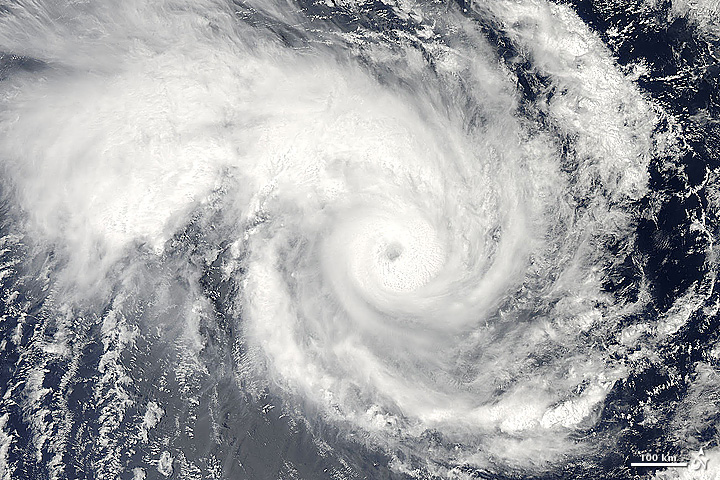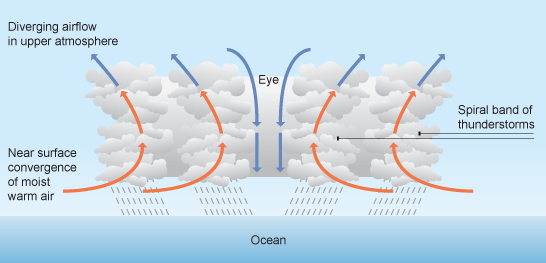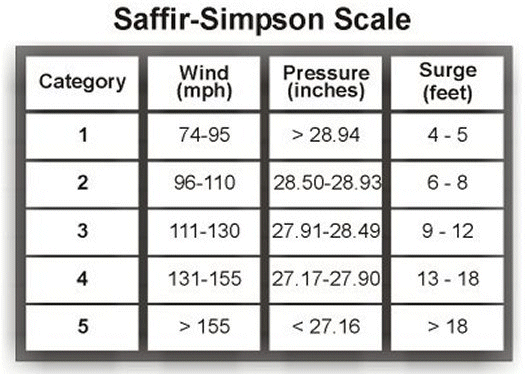Lesson 1 - What is a tropical storm? Where do they form?
Learning objectives:
- to know what a tropical storm is
- to be able to explain the physical processes leading to the formation of a tropical storm
- to be able to describe the locations in which we find tropical storms
- to know how the Saffir-Simpson scale is used to classify tropical storms
Note: Depending on where you are in the world, you may call the tropical sotrm by a different name. In the USA, they are referred to as hurricanes; in Bangladesh, they are called tropical cyclones; in Japan, people speak of typhoons; in Australia, they have willw-willies. All of these terms refer to the same weather event. We will call them tropical storms unless we are referring to specific storms, in which case they will be given local names (eg. Hurricane Katrina; Cyclone Nargis).
Tropical storms are areas of intense low pressure. On a satellite image, a tropical storm will show as a huge, swirling mass of cloud. The eye (calm area) is at the centre. You can see this in the image below. It shows Tropical Storm Edzani over the Southern Indian Ocean and was taken on 7th January 2010.

There are several stages in the formation of a tropical storm. These storms occur over water in areas where the sea surface temperature is at least 27 degrees. Essentially, this means that they form between the Tropic of Cancer and the Tropic of Capricorn (hence the name 'tropical' storm). They rarely occur within 5 degrees either side of the equator because the Coriolis force is too weak here.

Tropical cyclones use warm, moist air as fuel. That is why they form only over warm ocean waters near the equator. The warm, moist air over the ocean rises rapidly upward from near the surface and becomes saturated with evaporated moisture. This means that there is less air left at the surface (i.e. low pressure). Air from surrounding areas with higher air pressure pushes in to the low pressure area to try to equalise the pressure. Then that “new” air becomes warm and moist and rises, too. As the warm air continues to rise, the surrounding air swirls in to take its place. Trade winds cause the moist air to spin inwards. As the warmed, moist air rises and cools off, the water in the air forms towering cumulonimbus thunderclouds (because there is a huge amount of condensation). The whole system of clouds and wind spins and grows, fed by the ocean’s heat and water evaporating from the surface. The diagram below shows a cross section through a tropical storm.

Storms that form north of the equator spin counterclockwise. Storms south of the equator spin clockwise. As the storm system spins faster and faster, an eye forms in the centre. It is very calm and clear in the eye, with very low air pressure. Higher pressure air from above flows down into the eye.
The video clip below explains this process in images.

When the winds in the rotating storm reach 39 mph, the storm is called a tropical storm. When the wind speeds reach 74 mph, the storm is officially a tropical cyclone, or hurricane. The strength of a storm is measured using the Saffir-Simpson scale, as shown in the table below.

Tropical cyclones usually weaken when they hit land, because they are no longer being fed by the energy from the warm ocean waters. In the northern hemisphere they track (i.e. move) westwards due to the Coriolis effect. The video clip below shows Hurricane Dean, from birth to death.

Useful weblinks:
BBC animation - the formation of a hurricane
NASA animated guide to the development and structure of tropical storms
Make a tropical storm - simulator
Investigate how winds work together to determine where a hurricane will strike - simulator
BBC Bitesize revision notes about the formation of tropical storms
Lesson 2 - The effects of tropical storms
Learning objectives:
- to be able to distinguish between primary and secondary effects of tropical storms
- to be able to categorise the effects of tropical storms into social, economic and environmental (SEE)
We have already seen that the effects of earthquakes and volcanoes can be classified into primary and secondary effects. The same is true of the effects of tropical storms. Primary effects are those that result directly from the event itself. Secondary effects are those that result from the primary effects. The exam specification states that you must be able describe effects in both of these categories.
Primary effects of tropical storms
Primary effects of tropical storms include high winds, torrential rain and storm surges at landfall (more about this one later on). There may also be localised tornadoes and waterspouts. These are all physical effects.
Secondary effects of tropical storms
Secondary effects of tropical storms are very wide-ranging. We tend to divide them into social, economic and environmental effects (the SEE classification). To remember this, think about how a good geographer must open their eyes and SEE the world!

Social effects of tropical storms
There are likely to be food and water shortages.
As a result of extensive flooding, people may catch water-borne diseases. This may eventually lead to death.
Communities are displaced from their homes, and may be broken up if the area is not restored. Many people are made homeless.
People suffer from stress due to loss of possessions and housing.
There may be looting of properties - domestic and commercial.
People may lose their jobs if they work in an industry that has been badly affected.
If insurance premiums rise in the future, some people may not be able to afford them and will consequently not be financially protected against future storms.
People might be stranded due to flooding - this will cause trauma.
Economic effects of tropical storms
There are the obvious costs of repairing any damage caused.
Insurance claims will be made, and this may cause the cost of insurance premiums to rise in the future.
Whilst businesses are closed, earnings (and profits) will be lost.
Crops may be damaged and exports lost. These may be a key source of income for the local economy.
Oil prices may increase (this was a significant effect in the aftermath of Hurricane Katrina).
Environmental effects of tropical storms (sometimes referred to as physical effects)
A huge amount of water is released in a tropical storm so there will be extensive flooding.
Flooding might led to swer systems being flushed out and spreading disease.
There will be structural damage to buildings and they may have to be pulled down and rebuilt. This is very costly. Other buildings may have broken windows, chimneys etc.
Roads and other infrastructure such as railways may be destroyed. This can lead to communication problems.
Electricity lines might be blown down and, as a result, people could be without power supplies.
Sensitive ecosystems may be destroyed and plant and animal habitats lost.
Sea fish are often killed because of silting, and freshwater fish may be killed in storm surges.
Fishing boats and other craft may be damaged.
Crops and livestock may be damaged or destroyed.
Mudslides become common because the soil is saturated. They will flow quickly down hillsides and may bury houses, crops and livestock (or even people).
Comments (0)
You don't have permission to comment on this page.